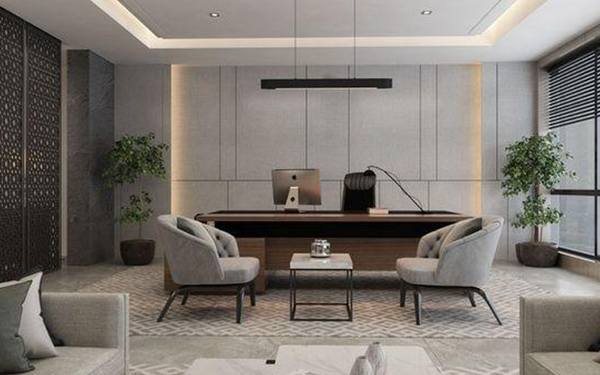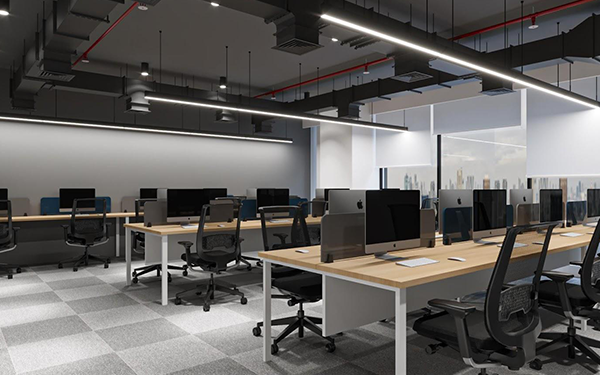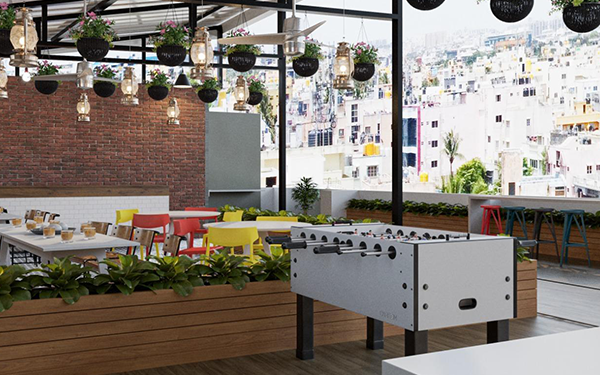Natural light is essential for creating a comfortable and healthy office interior design space. It not only helps reduce eye strain and headaches, but also enhances productivity and promotes employee well-being. Here are some tips for maximizing natural light in an office interior design space:
1.Use light-colored walls and floors:
Light colors reflect light, making the room appear brighter and more spacious. White or light-colored walls and floors can help bounce natural light throughout the room.


2.Position desks near windows:
When designing your office interior design space, position desks and workstations near windows to maximize natural light. This can help reduce the need for artificial lighting and also provide a better view for employees.
3.Use sheer curtains or blinds:
Sheer curtains or blinds can filter harsh sunlight and reduce glare while still allowing natural light to pass through. This can create a softer and more comfortable lighting environment.
4.Remove obstacles:
Make sure that the windows are not obstructed by furniture or other objects.This can prevent natural light from entering the room and make the space feel darker and more cramped.

5.Consider skylights:
If possible, consider installing skylights to bring natural light into your office interior design space. Skylights can be a great way to increase natural light while also adding a unique architectural feature to your space.
6. Use light-reflecting materials:
Materials such as mirrors, glass, and polished metals can reflect light and help spread it throughout the room. This can be especially effective in smaller or darker spaces.
7.Keep windows clean:
Dirty or dusty windows can reduce the amount of natural light that enters the room. Regularly clean your windows to ensure that you are maximizing natural light in your office interior design space.
By following these tips, you can maximize natural light in your office interior design space, creating a brighter, more comfortable, and more productive environment for your employees.
When it comes to optimizing the acoustics in an office interior design, there are several steps you can take to create a more comfortable and productive environment for employees. Add Acoustic Panels: While designing office interior design, acoustic panels are designed to absorb sound and reduce noise levels in a room. They can be installed on walls, ceilings, and even floors to help absorb sound waves and reduce noise.

1.Use Carpets and Rugs:
Hard surfaces like concrete or hardwood floors can create echoes and increase noise levels in an office interior design. Adding carpets and rugs can help absorb sound and reduce noise levels.
2.Control Noise Sources:
Identify sources of noise in the office interior and take steps to control them. For example, if the air conditioning unit is noisy, consider installing a quieter unit or moving it to a location where it won't disturb employees.

3.Install Sound Masking:
Sound masking systems emit a low level of background noise that helps to mask other noises in the environment. This can help to create a more comfortable and productive work environment.
4.Optimize Furniture Placement:
The placement of furniture in an office interior design can have a big impact on the acoustics. Try to position desks and workstations in a way that minimizes noise and echoes.
5.Encourage Quiet Spaces:
Provide areas where employees can go to work in silence or take a break from the noise of the office interior design. This can be a small conference room, a quiet corner, or even a designated outdoor space.

By following these tips, you can create a more comfortable and productive work environment by optimizing the acoustics in your office interior design.
When designing a creative office interior design space, there are several unique features to consider that can enhance productivity, creativity, and overall employee satisfaction. Here are some of the most important features to keep in mind:

1.Flexible workspaces:
The ability to adapt the workspace to different needs and activities is essential. Creating areas that can be reconfigured quickly and easily will make it possible to accommodate different types of work, including individual work, group work, and collaborative projects.

2.Natural lighting:
Incorporating natural light into the office interior design space is a crucial feature to consider. Research has shown that exposure to natural light can improve mood, productivity, and overall well-being.
3.Ergonomic furniture:
Comfortable and ergonomic furniture is essential for a productive and healthy work environment. Invest in high-quality chairs, desks, and other pieces of furniture that provide proper support and alignment for the body.

4.Greenery:
Adding plants and greenery to the office interior design space can have a positive effect on the environment. Plants can improve air quality, reduce noise levels, and boost overall well-being.

5.Colorful accents:
Colorful accents can add a playful and creative touch to the office interior design space. Consider incorporating colorful accents such as bold artwork, decorative pillows, and accent walls to add some character to the space.
6.Collaborative spaces:
Creating collaborative office interior design spaces that encourage teamwork and brainstorming is a critical feature to consider. These spaces can include conference rooms, breakout areas, and communal workspaces.
7.Technology integration:
Incorporating technology into the office interior design space can enhance productivity and collaboration. Consider integrating tools such as digital whiteboards, project management software, and video conferencing technology to streamline workflows and facilitate communication.

Overall, when designing a creative office interior design space, it's essential to prioritize flexibility, comfort, and collaboration. By incorporating these features into the design, you can create a workspace that inspires creativity, fosters productivity, and supports the well-being of your employees.
Greenery in an office interior design environment has been found to provide numerous benefits, not just for the employees but also for the company as a whole. Here are some of the key benefits of having greenery in an office interior design:

1.Improved air quality:
Indoor plants are known to remove toxins from the air, which can lead to improved air quality in the office. This can reduce the risk of respiratory problems and other health issues for employees.
2.Increased productivity:
Studies have shown that having plants in the workplace can increase productivity levels among employees. This may be due to the calming effect of greenery, which can reduce stress and increase focus.

3.Reduced stress:
The presence of greenery has been found to have a calming effect on employees, which can help to reduce stress levels. This can lead to improved mental health and wellbeing, as well as reduced absenteeism due to illness.

4.Enhanced creativity:
Greenery in the office interior design has been linked to increased creativity and innovation. This may be because plants can help to stimulate the brain and improve cognitive function.
5.Improved aesthetics:
Plants can add a decorative touch to the office, making it a more visually appealing and welcoming environment. This can help to create a positive impression on clients and visitors.

6.Increased employee satisfaction:
office interior design Providing a green workspace can help to improve employee satisfaction and retention rates. This is because employees are more likely to feel valued and cared for when their workplace is designed with their wellbeing in mind.
In conclusion, incorporating greenery into the office interior design environment can have numerous benefits, including improved air quality, increased productivity, reduced stress, enhanced creativity, improved aesthetics, and increased employee satisfaction. As a result, it is worth considering investing in indoor plants to create a healthier and more welcoming workplace.